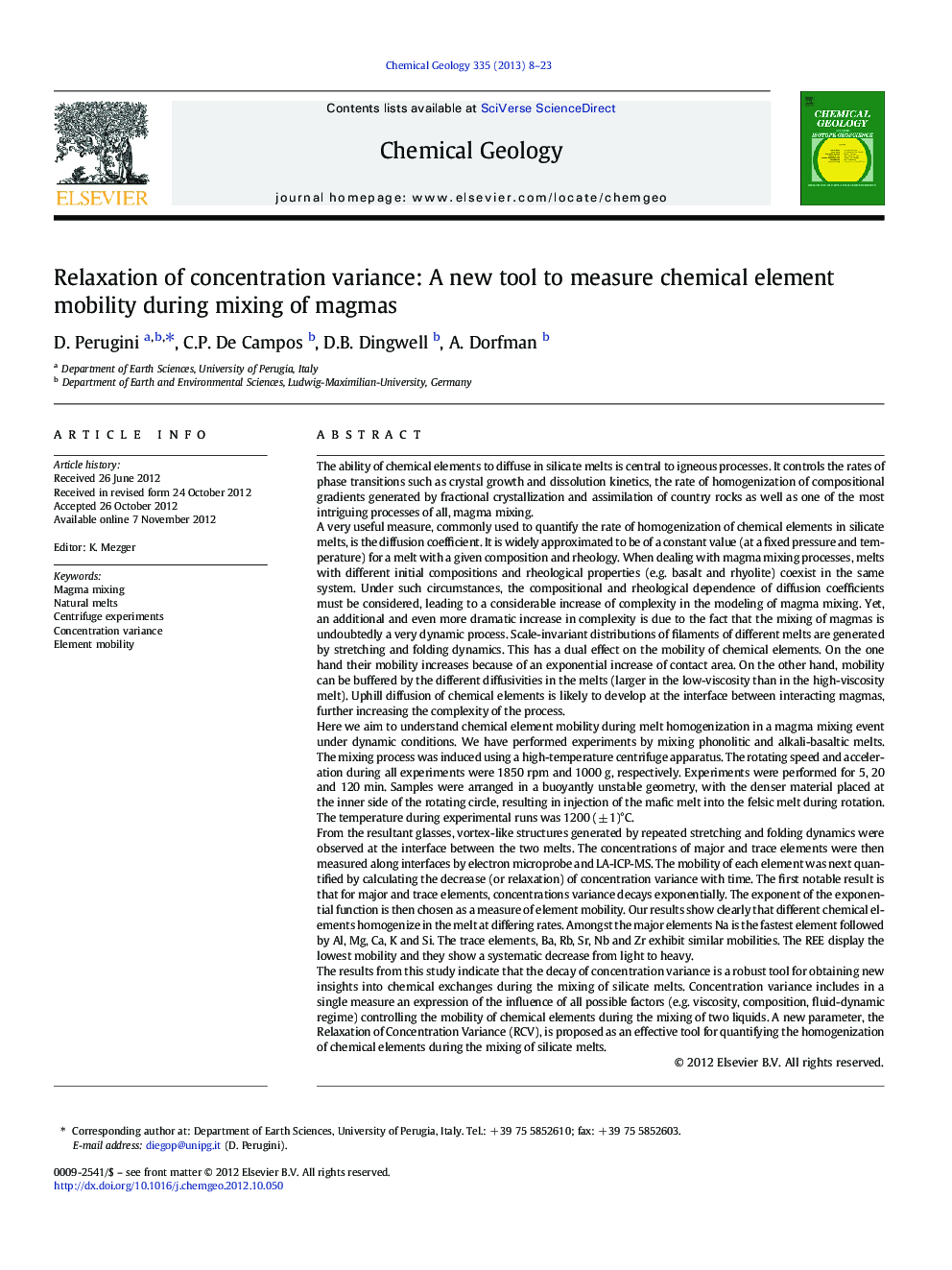| کد مقاله | کد نشریه | سال انتشار | مقاله انگلیسی | نسخه تمام متن |
|---|---|---|---|---|
| 4699102 | 1637632 | 2013 | 16 صفحه PDF | دانلود رایگان |
The ability of chemical elements to diffuse in silicate melts is central to igneous processes. It controls the rates of phase transitions such as crystal growth and dissolution kinetics, the rate of homogenization of compositional gradients generated by fractional crystallization and assimilation of country rocks as well as one of the most intriguing processes of all, magma mixing.A very useful measure, commonly used to quantify the rate of homogenization of chemical elements in silicate melts, is the diffusion coefficient. It is widely approximated to be of a constant value (at a fixed pressure and temperature) for a melt with a given composition and rheology. When dealing with magma mixing processes, melts with different initial compositions and rheological properties (e.g. basalt and rhyolite) coexist in the same system. Under such circumstances, the compositional and rheological dependence of diffusion coefficients must be considered, leading to a considerable increase of complexity in the modeling of magma mixing. Yet, an additional and even more dramatic increase in complexity is due to the fact that the mixing of magmas is undoubtedly a very dynamic process. Scale-invariant distributions of filaments of different melts are generated by stretching and folding dynamics. This has a dual effect on the mobility of chemical elements. On the one hand their mobility increases because of an exponential increase of contact area. On the other hand, mobility can be buffered by the different diffusivities in the melts (larger in the low-viscosity than in the high-viscosity melt). Uphill diffusion of chemical elements is likely to develop at the interface between interacting magmas, further increasing the complexity of the process.Here we aim to understand chemical element mobility during melt homogenization in a magma mixing event under dynamic conditions. We have performed experiments by mixing phonolitic and alkali-basaltic melts. The mixing process was induced using a high-temperature centrifuge apparatus. The rotating speed and acceleration during all experiments were 1850 rpm and 1000 g, respectively. Experiments were performed for 5, 20 and 120 min. Samples were arranged in a buoyantly unstable geometry, with the denser material placed at the inner side of the rotating circle, resulting in injection of the mafic melt into the felsic melt during rotation. The temperature during experimental runs was 1200 (± 1)°C.From the resultant glasses, vortex-like structures generated by repeated stretching and folding dynamics were observed at the interface between the two melts. The concentrations of major and trace elements were then measured along interfaces by electron microprobe and LA-ICP-MS. The mobility of each element was next quantified by calculating the decrease (or relaxation) of concentration variance with time. The first notable result is that for major and trace elements, concentrations variance decays exponentially. The exponent of the exponential function is then chosen as a measure of element mobility. Our results show clearly that different chemical elements homogenize in the melt at differing rates. Amongst the major elements Na is the fastest element followed by Al, Mg, Ca, K and Si. The trace elements, Ba, Rb, Sr, Nb and Zr exhibit similar mobilities. The REE display the lowest mobility and they show a systematic decrease from light to heavy.The results from this study indicate that the decay of concentration variance is a robust tool for obtaining new insights into chemical exchanges during the mixing of silicate melts. Concentration variance includes in a single measure an expression of the influence of all possible factors (e.g. viscosity, composition, fluid-dynamic regime) controlling the mobility of chemical elements during the mixing of two liquids. A new parameter, the Relaxation of Concentration Variance (RCV), is proposed as an effective tool for quantifying the homogenization of chemical elements during the mixing of silicate melts.
► We perform magma mixing experiments between natural melts using a centrifuge.
► We examine the space and time modulation of compositional fields.
► We quantify chemical element mobility using the concentration variance.
► Chemical elements attain the hybrid composition at different times.
Journal: Chemical Geology - Volume 335, 6 January 2013, Pages 8–23
